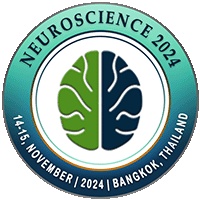
Marco Poloni
Milano, IRCCS Mario Negri, ItalyTitle : The differential diagnosis of neurofibromatoses
Abstract
Neurofibromatoses are neurocutaneous diseases with similar pathogenesis. The first description of NF1 is due to von Recklinghausen in 1882, while a NF2 case was described since 1822 but remained joined to NF eponym since 100 years later, as its central variant; only in 1993 these diseases were recognized as totally different, being carried by different chromosomes (17 for NF1, 22 for NF2), respectively encoding Neurofibromin and Merlin or Schwannomin, both proteins with tumor suppression activity; both diseases display autosomal dominant transmission and exhibit high rate of penetrance with mosaicism in several (20-30 %) cases; mutations of SMARCB1 and LZTR1 genes have been described typical of Schwannomatosis. NF1 is much more frequent than NF2, featuring cutaneous, sub-cutaneous and plexiform neurofibromas, Lish nodules, café-au-lait macules (CALMS), freckling, learning disabilities and skeletal malformations together with Central Nervous System and Spinal tumors (glioma, astrocytoma and meningioma); 10% possibility of malignant transformation exists. Neurologic, cognitive and Psychiatric abnormalities are significant and will reviewed much more deeply. The cardinal manifestation of NF2 is bilateral cochlear-vestibular schwannoma with additional tumors (cranial nerves and radicular schwannoma, meningioma, brain or spinal ependymoma); cutaneous signs are less frequent than in NF1, but the prognosis, due to brain tumors, is worst. In Schwannomatosis several schwannomas tipically arise on peripheral nerves with pain spontaneous or at pressure; VIII°nerve tumors are lacking. Imaging diagnostic is extremely useful to localize di focal areas of T2 hyperintensity and their extension corresponding to NF1 amartomas or tumors; on the contrary a strict follow-up of lesions in NF2 by cranial and spinal MRI is always mandatory while imaging by Total Body MRI or PET is required for the diagnosis in schwannomatosis. Differential diagnosis includes the Legius syndrome, carried by chromosome 15, displaying cutaneous alterations like NF1, learning disabilities, but no tumor predisposition; other diseases featuring CALMS exists together with peculiar tissue abnormalities, like Noonan, Watson and Leopard syndromes; on the other hand Proteus syndrome, known also as “Elephant-man”, is characterized by asymmetrical tissue overgrowth with deformities.
Biography
Marco Poloni , volunteer researcher, IRCCS Mario Negri of Milan: “Head trauma is certainly not linked only to road accidents, but also to accidental falls, now the leading cause in people of a certain age in industrialized countries. Even trivial head injuries can be important because if they recur they cause greater damage than a single head injury. Generally, in neurology, non-specific neurological events are much more frequent in those who have had a head injury, more precisely there are pathologies that recognize the head injury event as one of the pathogenesis reasons. Among these is Parkinson's, just think of the case of boxer Cassius Clay, but also dementia ”.

